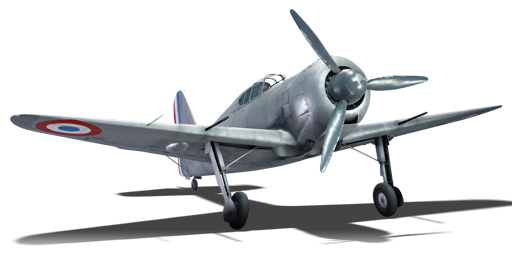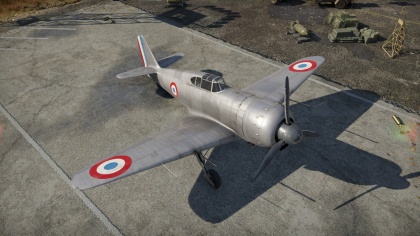Difference between revisions of "M.B.157"
(Edits, moved history section towards a more appropriate area.) |
|||
| Line 249: | Line 249: | ||
* ''other literature.'' | * ''other literature.'' | ||
| + | {{AirManufacturer Bloch}} | ||
{{France fighters}} | {{France fighters}} | ||
Revision as of 18:36, 31 December 2019
Contents
Description
The M.B.157 is a rank French fighter
with a battle rating of (AB), (RB), and (SB). This aircraft was introduced in Update 1.73 "Vive la France".
General info
Flight Performance
The M.B.157 is a solid aircraft and with the Gnome-Rhône 14R engine which has a 1,181 maximum horsepower output. This aircraft has good manoeuvrability and acceleration allowing it to perform well in battle. While this aircraft has good acceleration, it is not a quick climber, and if you intend to fight from above, this aircraft will need to side-climb to the desired altitude. Due to the weight of the aircraft and its excellent energy retention, this fighter makes a great Boom & Zoom aircraft. With the beefed up wings of the MB.157 they are virtually unrippable as their sheer speed is at 810 km/h; however, the combat flaps will begin to detach around 450 km/h and the landing gear at 340 km/h.
This aircraft has a decent roll and turn rate; however, extending combat flaps will aid in reducing turn time. Utilising the powerful rudder along with combat flaps allow for this aircraft to make tighter rolls and turns than with only using ailerons and elevators. Taking the M.B.157 into a steep climb during a rope-a-dope allows for the pilot to kick the rudder either direction at the peak of the climb (near stall speed) and perform a quick wing-over or hammerhead turn putting the pilot on the hunt for the stalled out chase aircraft. While this aircraft excels at Boom & Zoom tactics, pilots should familiarise themselves with this aircraft in a dive as control stiffening begins at around 450 km/h and almost full control lock-up begins after 650 km/h.
This aircraft cannot outfit external ordinances on underwing or belly pylons which would affect the weight and drag of this flight model.
For those pilots flying who desire to, the cockpit canopy can be left open during flight.
| Characteristics | |||||||
|---|---|---|---|---|---|---|---|
| Stock | |||||||
| Max Speed (km/h at 7,600 m) |
Max altitude (meters) |
Turn time (seconds) |
Rate of climb (meters/second) |
Take-off run (meters) | |||
| AB | RB | AB | RB | AB | RB | ||
| 679 | 664 | 9,000 | 20.3 | 20.7 | 10.1 | 10.1 | 650 |
| Upgraded | |||||||
| Max Speed (km/h at 7,600 m) |
Max altitude (meters) | Turn time (seconds) | Rate of climb (meters/second) |
Take-off run (meters) | |||
| AB | RB | AB | RB | AB | RB | ||
| 748 | 712 | 9,000 | 18.3 | 19.0 | 23.2 | 14.1 | 650 |
Details
| Features | ||||
|---|---|---|---|---|
| Combat flap | Take-off flap | Landing flap | Air brakes | Arrestor gear |
| ✓ | ✓ | ✓ | X | X |
| Limits | ||||
|---|---|---|---|---|
| Wing-break speed (km/h) |
Gear limit (km/h) |
Combat flap (km/h) |
Max Static G | |
| + | - | |||
| 810 | 340 | 450 | ~?? | ~? |
| Optimal velocities | |||
|---|---|---|---|
| Ailerons (km/h) |
Rudder (km/h) |
Elevators (km/h) |
Radiator (km/h) |
| < ??? | < ??? | < ??? | > ??? |
| Compressor (RB/SB) | ||
|---|---|---|
| Setting 1 | ||
| Optimal altitude | 100% Engine power | WEP Engine power |
| ?,??? m | ??? hp | ?,??? hp |
Survivability and armour
- 10 mm Steel plate behind the engine
- 10 mm Steel plate behind the pilot's head
- 3 mm Steel plate box in the fuselage
The M.B.157 has some protective armour to protect the pilot. The largest piece of armour is the 10 mm steel plate located behind the engine and in front of the cockpit. Secondly, there is a 10 mm steel plate in the pilot’s headrest to protect the pilot from bullets striking from behind. Thirdly there is a 3 mm steel box located behind the pilot and near the control surface linkage. Bullet-proof glass was not available on this aircraft making the pilot susceptible to being hit from head-on, top-down and side attacks. Critical components of the aircraft such as the engine, oil cooling system and the pilot’s head are exposed during head-on attacks or while attacking bombers from behind. While the fuel tanks are protected from head-on attacks (situated below the pilot), unfortunately, they are vulnerable from almost every other angle.
Armaments
Offensive armament
- 2 x 20 mm Hispano 404 machine guns (60 rpg = 120 total)
The Hispano 404 on the M.B.157 are excellent weapons, utilised on many different aircraft, but the big drawback on this plane is that each cannon is drum fed and has only 60 rounds per gun. With a firing rate of 700 rounds per minute, the expending of ammunition very quickly is a reality. The pilot cannot rely on continuous fire due to the quickness of ammunition depletion and must practice well aimed, controlled bursts to conserve ammunition and make every shot count. Unless the pilot is highly skilled and comfortable with the Stealth belt ammunition, achieving more accurateshots require utilising the Default, Universal, or Ground Attack rounds which all contain tracer rounds in their mix.
Usage in battles
The M.B.157 has good energy retention and does well with Boom & Zoom tactics. While turn-fighting is not recommended as typically, this will leave you with low energy and a slow plane, if needed, you can utilise combat flaps and rudder to help make sharper turns when chasing down other aircraft or trying to dodge enemy aircraft fire. The .157 is an aircraft which can excel when it has an energy advantage over the enemy and to do so needs to side-climb on the map in order to get to a decent altitude. For this fighter, speed is key and having enough room to dive and zoom away will extend the pilot’s ability to survive and line up another shot.
While the 60 rounds per gun are a pittance in any of the battle types, it is especially critical in Realistic or Simulator Battles. Arcade can get away with flying around while waiting out the reload time; however, Realistic or Simulator pilots will need to return to the base to reload before taking on any more enemy aircraft.
Manual Engine Control
| MEC elements | ||||||
|---|---|---|---|---|---|---|
| Mixer | Pitch | Radiator | Supercharger | Turbocharger | ||
| Oil | Water | Type | ||||
| Not controllable | Controllable Automatic pitch |
Controllable | Not controllable | Combined | Controllable | Not controllable |
Modules
| Tier | Flight performance | Survivability | Weaponry | |
|---|---|---|---|---|
| I | Fuselage Repair | Radiator | Offensive 20 mm | |
| II | Compressor | Airframe | ||
| III | Wings Repair | Engine | New 20 mm Cannons | |
| IV | Engine Injection | Cover | ||
Pros and cons
Pros:
- Quite fast compared to peers
- Good energy retention
- Two cannons
- Acceptable rate of climb (When fully upgraded)
Cons:
- Low ammo count - you need to make all your shots count
- Control stiffening occurs at high speeds (during dives)
- Minimal armour to sides and behind pilot.
- Easily pilot sniped when flying near to bombers
History
Early development in 1934 by Société des Avions Marcel Bloch produced the Bloch M.B.150 single seat, all-metal low-wing monoplane fighter featuring a fully enclosed cockpit and retractable landing gear. While not initially chosen by the French Air Ministry for production, development continued on this aircraft. Following several setbacks and operational problems, a modified prototype was finally able to attain flight in 1937. Several additional modifications were necessary to refine this aircraft which included a more robust and strengthened wing and utilising the 14-cylinder two-row air-cooled radial Gnome-Rhône 14N-7 engine. During 1938 after running several trial runs, 25 preproduction aircraft were ordered.
Further testing refined the aircraft taking it to the improved version MB.151 and MB.152 which entered service at the outbreak of World War II. Unfortunately, most were determined to be unfit for combat service. Further testing led to the M.B.155 which had greater range and saw service until the fall of France. Not to be deterred, Vichy France completed several upgrades improving the flight model and installing the more powerful Gnome-Rhône 14R engine which lead to the designation of M.B.157. Unfortunately, this aircraft never entered service with only one prototype M.B.157 built.
Media
See also
Links to the articles on the War Thunder Wiki that you think will be useful for the reader, for example:
- reference to the series of the aircraft;
- links to approximate analogues of other nations and research trees.
External links
Paste links to sources and external resources, such as:
- topic on the official game forum;
- encyclopedia page on aircraft;
- other literature.
Template:AirManufacturer Bloch
| France fighters | |
|---|---|
| Dewoitine | D.371 · D.371 H.S.9 · D.373 · D.500 · D.501 · Pallier's D.510 · D.520 |
| Morane-Saulnier | M.S.405C1 · M.S.406C1 · M.S.410 |
| Arsenal | V.G.33C-1 |
| Bloch | M.B.152C1 · M.B.157 |
| Caudron | C.R.714 |
| Sud-Ouest | S.O.8000 Narval |
| American | H-75A-1 · H-75A-4 · ▄P-39Q-25 · ▄P-40F-5 Lafayette · ▄P-47D-22-RE · ▄P-63C-5 · F-6C-10-NA |
| ▄F6F-5 · ▄F6F-5N · F4U-7 · ▄F8F-1B | |
| Other countries | ▄Seafire LF Mk.III · ▄Yak-3 · Challe's ▄Yak-9T · NC.900 |
| Belgium | ▄Gladiator Mk I · ▄Spitfire FR Mk XIVe |
| Netherlands | ◘Sea Fury FB 51 |





